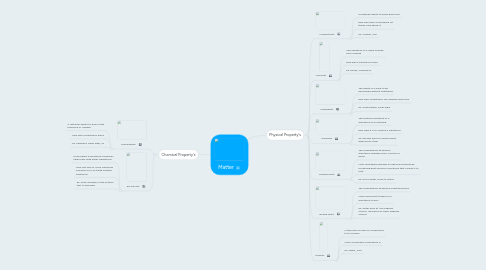
1. Chemical Property's
1.1. Flammability
1.1.1. A materials ability to burn in the presence of Oxygen.
1.1.2. How well a substance burns
1.1.3. Ex: children's sleep wear, oil
1.2. Re-activity
1.2.1. How readily a substance combines chemically with other substances
1.2.2. How fast two or more chemicals combine or re-act with another substance
1.2.3. Ex: Rust Nitrogen in the bottom part of big ships
2. Physical Property's
2.1. Conductivity
2.1.1. a materials ability to allow heat flow.
2.1.2. how well does a substance let things flow threw it.
2.1.3. Ex: Copper, Iron
2.2. Viscosity
2.2.1. The Tendency of a liquid to keep from flowing
2.2.2. how well a substance flows
2.2.3. Ex: honey, cooking oil
2.3. Malleability
2.3.1. The ability of a solid to be hammered without shattering
2.3.2. how well a substance can change solid form
2.3.3. Ex: Gold jewelry, silver wear
2.4. Hardness
2.4.1. The relative resistance of a substance to scratching
2.4.2. how hard it is to scratch a substance
2.4.3. Ex: Kitchen knife & copper sheet, diamond to steel.
2.5. Melting point
2.5.1. The Temperature at which a substance changes from a solid to a liquid.
2.5.2. How something changes its physical property by increasing heat around a substance that causes it to melt
2.5.3. Ex: ice to water, snow to water
2.6. Boiling point
2.6.1. The Temperature at which a substance boils
2.6.2. How much heat it takes for a substance to boil
2.6.3. Ex: water boils at 100 Degrees Celsius, Gold boils at 2856 Degrees Celsius
2.7. Density
2.7.1. Is the ratio of mass of a substance to its volume
2.7.2. How compacted a substance is
2.7.3. Ex: Water, Fuel

